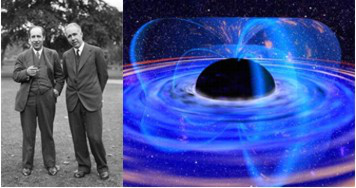Gustav Holzegel
(Cambridge)
09/04/2008, 15:15
Yvonne Choquet-Bruhat
(Paris Jussieu)
11/04/2008, 09:30
Tobias Wiseman
(Imperial College)
11/04/2008, 10:20
Ricci flow potentially provides a tool to allow explicit numerical
construction of black hole metrics of interest in physics.
Whilst in 4 dimensions stationary black holes of interest are known
analytically, I will discuss how black holes in theories with extra
dimensions (such as string theory) are generally not known
analytically. Then a numerical construction of the metric is...
Roberto Emparan
(Barcelona)
11/04/2008, 14:15
After a review of our current knowledge about
higher-dimensional black holes, I will discuss some problems that
arise due to novel types of black holes that do not arise in four
dimensions. In particular, the absence of uniqueness, and the
existence of horizons with the geometry of a product space seem to
require new ideas and tools in order to achieve a better
characterization and...
Troels Harmark
(Niels Bohr Institute)
11/04/2008, 15:05
We consider stationary and axisymmetric solutions in General
Relativity, primarily in five dimensions. We motivative the
introduction of the Rod-structure for any given solution and give
examples of Rod-structures for various five-dimensional exact
solutions of General Relativity. We consider the questions of
uniqueness and existence of a solution given the Rod-structure.
Finally we...
Helmut Friedrich
(AEI Golm)
12/04/2008, 11:35
We give a complete description of the asymptotically flat,
conformally non-flat, static vacuum data which admit conformal
mappings onto other such data which extend smoothly to space-like
infinity. These data form a 3-parameter family which decomposes into
1-parameter families of data which are conformal to each other
Juan A Valiente
(Queen Mary, London)
14/04/2008, 11:00
H. Friedrich has shown that if one considers a time symmetric initial
data set for the Einstein vacuum equations admitting an analytic
compactification at infinity, then necessary conditions for the
solutions to the transport system implied by the conformal Einstein
equations at the cylinder at spatial infinity to extend smoothly to
the critical sets where null infinity touches spatial...
Hans Ringstrom
(Stockholm (KTH))
14/04/2008, 14:00
In the case of Einstein's equations coupled to a non-linear
scalar field with a suitable exponential potential, there are
solutions for which the expansion is accelerated and of power law
type. In the talk I will discuss the future global non-linear
stability of such models. The results generalize those of Mark Heinzle
and Alan Rendall obtained using different methods.
Lars Andersson
(AEI Golm)
15/04/2008, 11:00
I will discuss recent results on existence and regularity of
marginal surfaces, blowup of Jang's equation, and regularity of the trapped
region. This is joint work with Jan Metzger.
Mihalis Dafermos
(Cambridge)
15/04/2008, 13:45
Mihalis Dafermos
(Cambridge)
16/04/2008, 15:15
Robert Beig
(Vienna)
17/04/2008, 11:00
The only rigorous result known so far on the existence of isolated bodies
in GR in rigid rotation are the ones by Heilig of 1995 on perfect fluids. We outline a method to solve the
stationary Einstein equations with source a body in rigid rotation consisting of elastic matter.
This is work in progress by R.B., B.G.Schmidt, and L.Andersson.

